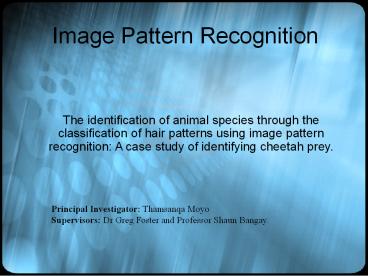Image Pattern Recognition - PowerPoint PPT Presentation
Title:
Image Pattern Recognition
Description:
The identification of animal species through the classification of hair patterns ... Image tessellation. Use of variance or average absolute deviation. Research Done: ... – PowerPoint PPT presentation
Number of Views:925
Avg rating:3.0/5.0
Title: Image Pattern Recognition
1
Image Pattern Recognition
- The identification of animal species through the
classification of hair patterns using image
pattern recognition A case study of identifying
cheetah prey.
Principal Investigator Thamsanqa
Moyo Supervisors Dr Greg Foster and Professor
Shaun Bangay.
2
Presentation Outline
- Problem Statement
- Objectives
- Approach
- Research Done
- Conclusion
3
Problem Statement
- Hair identification in Zoology and Forensics
- Subjectivity
4
Problem Statement
- First application of automated image pattern
recognition techniques to the problem of
classifying African mammalian species using hair
patterns. - based on the numerical and statistical analysis
of hair patterns.
5
Approach to the Study
- Lack of literature focused on hair recognition
- Multi-disciplinary nature
- New process designed
6
Approach to the StudyProcess Stages
Feature Generation
Feature Selection
Classifier Design
System Evaluation
Image Capture
Sensor
- Each stage detailed next
Figure Adapted from Theodoris et al (20036)
7
Research Done
Image Capture
- How can hair pattern images be captured?
- Based in Zoology Department
- 2 approaches considered
Light Microscope
SEM
8
Research Done
Image Capture
SEM
Light Microscope
Scale Patterns
Cross Section Patterns
9
Research Done
Image Capture
- Scale Patterns
- Use SEM
- Better representation of texture in image
Light Microscope
SEM
10
Research Done
Image Capture
- Cross section patterns
- Use Light microscope
- 2D shape preferred to a 3D shape
Light Microscope
SEM
11
Research Done
Image Capture
- Decisions affecting design
- Scale patterns texture based
- Cross section patterns shape based
- 2 separate sub-processes
- Decision not to combine their results
12
Research Done Sensor
- What image manipulation techniques are applied in
a hair pattern recognition process? - Scale Pattern Processing
- User defined ROI
- Handle RST variations
- No need to cater for reflection variations
- Convert to greyscale
13
Research Done Sensor Stage
- What image manipulation techniques are applied in
a hair pattern recognition process? - Cross section pattern processing
- User defined ROI
- Image segmentation and thresholding
- Challenges
14
Research Done Sensor Stage
Original
Thresholding
Edge Detection
Grab Cut Thresholding
15
Research Done
Sensor Stage
- Findings
- Most sensitive stage of the process
- Cross section patterns best extracted with Grab
Cut - Contributions
- First test of Grab Cut technique in a real world
problem
16
Research Done Feature Extraction
- How can features be extracted?
- Scale Pattern Processing
- Gabor filters
- Capture pattern orientation and frequency
information - Produces n number of filtered images where n is
the size of the Gabor filter-bank
17
Research Done Feature Extraction
Filtered Images from a Gabor Filter of size 4.
Images filtered at initial orientation of 0
degrees
Images filtered at initial orientation of 180
degrees
18
Research Done Feature Extraction
- How can features be extracted?
- Cross Section Processing
- Hus 7 moments
- RST invariant shape descriptors
- Calculated from central moments
- Require black and white image
19
Research Done Feature Selection
- What selection of features is necessary
- Scale Pattern Processing
- Image tessellation
- Use of variance or average absolute deviation
20
Research Done Feature Selection
- What selection of features is necessary?
- Cross section processing
- None required for Hus moments
- Would affect scalability of the process
21
Research Done Classifier Design
- What mechanisms can be used to classify features?
- Scale Pattern Processing
- Euclidean distance measure
- 3 Scale patterns used to train
- Cross Section Processing
- Euclidean distance measure or Hamming distance
measure - 10 cross section patterns used to train
22
Research Done Results
- From implementation using
- ImageJ plugins written in Java 1.4
- 25 scale patterns processed
- 50 cross section patterns processed
23
Research Done Results
Scale pattern results (Variance)
24
Research Done Results
Scale pattern results (AAD)
25
Research Done Results
- Summary of scale pattern results
- AAD is a better feature selection method
- Results most stable with 8 filters using AAD as
feature selector - Explanation of this result
26
Research Done Results
Cross section pattern results
27
Research Done Results
- Summary of cross section pattern results
- Euclidean distance overall classification rate
26 - Hamming distance overall classification rate 40
- Explanation of this result
28
Conclusion
- Findings and Contributions
- Gabor filters and moments shown to provide hair
pattern classification information - AAD performs better feature selection than
variance - Hamming distance more suitable classifier of
moments than Euclidean distance - First application of hair pattern recognition on
African mammalian species hair.
29
Questions
- Manual Preparation Work
- Sensor
- Feature extraction
- Feature Selection
- Classifier Design
- Results































